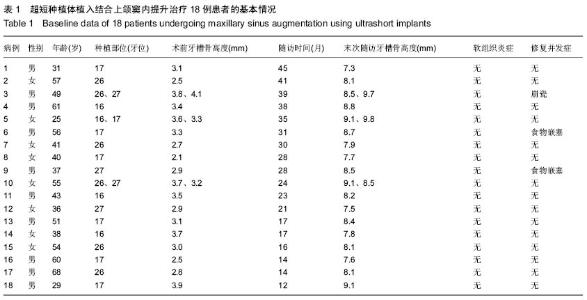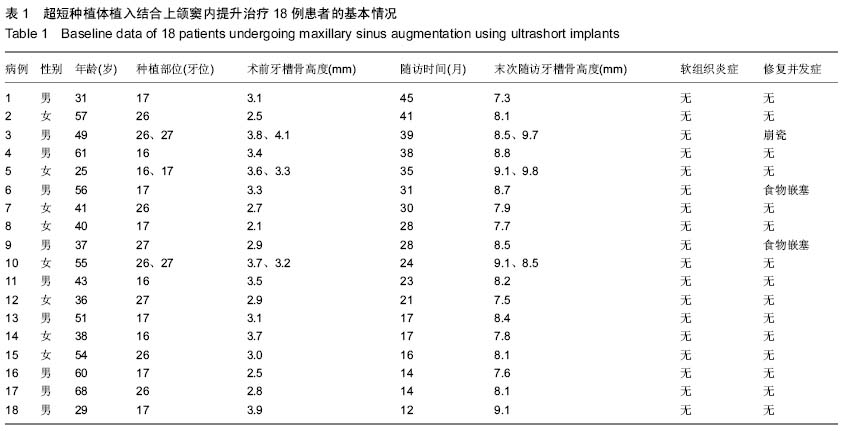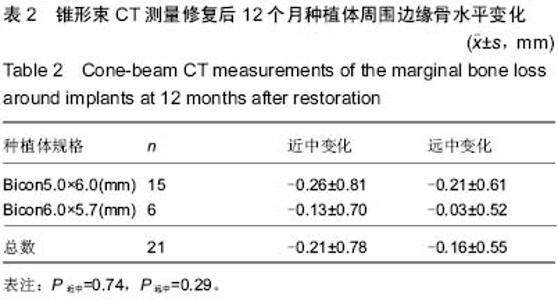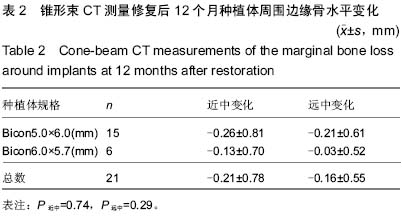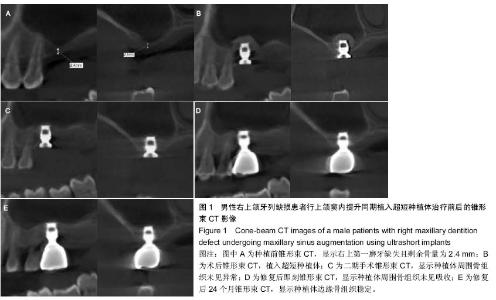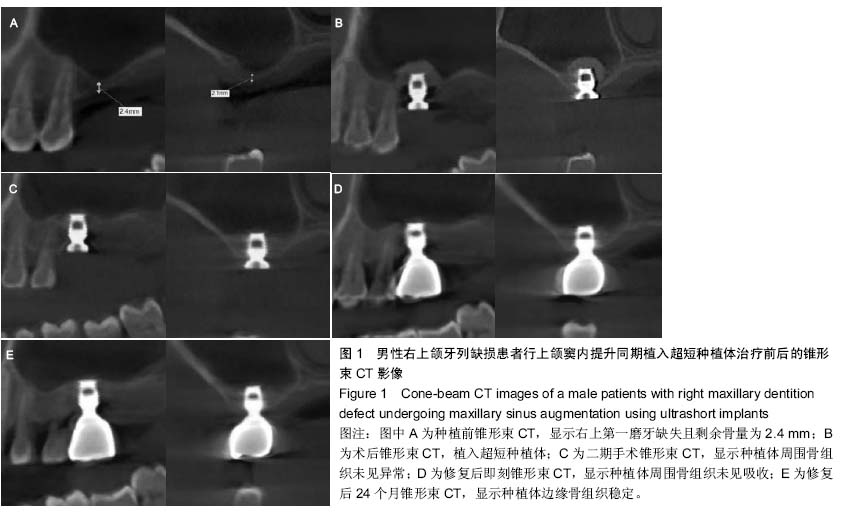Chinese Journal of Tissue Engineering Research ›› 2015, Vol. 19 ›› Issue (30): 4810-4814.doi: 10.3969/j.issn.2095-4344.2015.30.011
Previous Articles Next Articles
Application of ultrashort implant in limited alveolar bone of the posterior maxilla
Huang Na1, Li Ping1, 2, Li An2, Dai Jing-tao1, 2, Wang Yuan-qin1, 2, Tang You-chao1, 2
- 1Department of Oral Implantology, Huizhou Stomatological Hospital of Jinan University, Huizhou 516000, Guangdong Province, China; 2Jinan University Medical School, Guangzhou 510632, Guangdong Province, China
-
Online:2015-07-16Published:2015-07-16 -
Contact:Tang You-chao, Chief physician, Department of Oral Implantology, Huizhou Stomatological Hospital of Jinan University, Huizhou 516000, Guangdong Province, China; Jinan University Medical School, Guangzhou 510632, Guangdong Province, China -
About author:Huang Na, Master, Attending physician, Department of Oral Implantology, Huizhou Stomatological Hospital of Jinan University, Huizhou 516000, Guangdong Province, China Li Ping, Master, Physician, Department of Oral Implantology, Huizhou Stomatological Hospital of Jinan University, Huizhou 516000, Guangdong Province, China; Jinan University Medical School, Guangzhou 510632, Guangdong Province, China Huang Na and Li Ping contributed equally to this work. -
Supported by:the Science and Technology Plan Project of Huizhou City, No. 2014Y112
CLC Number:
Cite this article
Huang Na, Li Ping, Li An, Dai Jing-tao, Wang Yuan-qin, Tang You-chao. Application of ultrashort implant in limited alveolar bone of the posterior maxilla[J]. Chinese Journal of Tissue Engineering Research, 2015, 19(30): 4810-4814.
share this article
| [1] Wallace SS,Froum SJ.Effect of maxillary sinus augmentation on the survival of endosseous dental implants. A systematic review.Ann Periodontol.2003;8(1): 328-343. [2] Wallace SS,Tarnow DP,Froum SJ,et al.Maxillary sinus elevation by lateral window approach: Evolution of technology and technique.J Evid Based Dent Pract.2012;12(3):161-171. [3] 吴佩玲,张晓倩,尼加提,等.上颌窦外提升中黏膜穿孔成因与修复后的种植[J].中国组织工程研究,2014,18(51):8223-8227. [4] Oh TJ,Yoon J,Misch CE,et al.The causes of early implant bone loss: Myth or science?J Periodontol.2002;73(3): 322-333. [5] Fermergärd R,Ästrand P.Osteotome sinus floor elevation and simultaneous placement of implants-a1-year retrospective study with astra tech implants.Clin Implant Dent Relat Res. 2008;10(1):62-69. [6] Nedir R,Nurdin N,Vazquez L,et al.Osteotome sinus floor elevation technique without grafting: A 5‐year prospective study.J Clin Periodontol.2010;37(11):1023-1028. [7] 邓飞龙,廖展澎,吴少伟,等.Bicon 短种植体临床效果1~3 年回顾性研究[J].中华口腔医学研究杂志(电子版),2013,7(3):50-53. [8] 王晗,李德超,朱扬,等.Ⅱ 类骨质下上颌窦区垂直骨高度不足时应用短种植体长度和直径的优化分析[J].中国组织工程研究, 2011,15(22):4069-4072. [9] Reinish E.Ole jensen, editor, the sinus bone graft (2nd edition). Alpha Omegan. 2006;99(3):151. [10] Urdaneta RA,Daher S,Leary J,et al.The survival of ultrashort locking-taper implants.Int J Oral Maxillofac Implants.2012; 27(3):644. [11] Emmerich D,Att W,Stappert C.Sinus floor elevation using osteotomes: A systematic review and meta-analysis.J Periodontol.2005;76(8):1237-1251. [12] Misch C.Short dental implants: A literature review and rationale for use. Dent Today.2005;24(8):64-66,68. [13] Olate S,Lyrio MC,de Moraes M,et al.Influence of diameter and length of implant on early dental implant failure.J Oral Maxillofac Surg.2010;68(2):414-419. [14] Fugazzotto PA.Shorter implants in clinical practice: Rationale and treatment results.Int J Oral Maxillofac Implants.2008; 23(3):487-496. [15] Maló P,de Araújo Nobre M,Rangert B.Short implants placed one-stage in maxillae and mandibles: a retrospective clinical study with 1 to 9 years of follow-up.Clin Implant Dent Relat Res.2007;9(1):15-21. [16] ten Bruggenkate CM,Asikainen P,Foitzik C,et al.Short (6-mm) nonsubmerged dental implants: results of a Multicenter clinical trial of 1 to 7 years.Int J Oral Maxillofac Implants.1998; 13(6):791-798. [17] Venuleo C,Chuang SK,Weed M,et al.Long term bone level stability on short implants: A radiographic follow up study.J Oral Maxillofac Surg.2008;7(3):341-344. [18] Sun HL,Huang C,Wu YR,et al.Failure rates of short (≤10 mm) dental implants and factors influencing their failure: A systematic review.Int J Oral Maxillofac Implants.2010;26(4): 816-825. [19] 郑先雨,何家才.Endopore短种植体在骨量不足颌骨种植中的应用[J].中国组织工程研究与临床康复,2008,12(36):7093-7096. [20] 李平,戴静桃,李安,等.种植体结构设计与种植体边缘的骨吸收: 现状与争议[J].中国组织工程研究,2014,18(21):3406-3411. [21] Bilhan H,Geckili O,Mumcu E,et al.Influence of surgical technique, implant shape and diameter on the primary stability in cancellous bone.J Oral Rehabil.2010; 37(12): 900-907. [22] Pierrisnard L,Renouard F,Renault P,et al. Influence of implant length and bicortical anchorage on implant stress distribution. Clin Implant Dent Relat Res.2003;5(4):254-262. [23] Hagi D,Deporter D,Pilliar R,et al.A targeted review of study outcomes with short (≤ 7 mm) endosseous dental implants placed in partially edentulous patients.J Prosthodont.2004; 75(6):798-804. |
| [1] | Chen Ziyang, Pu Rui, Deng Shuang, Yuan Lingyan. Regulatory effect of exosomes on exercise-mediated insulin resistance diseases [J]. Chinese Journal of Tissue Engineering Research, 2021, 25(25): 4089-4094. |
| [2] | Chen Yang, Huang Denggao, Gao Yuanhui, Wang Shunlan, Cao Hui, Zheng Linlin, He Haowei, Luo Siqin, Xiao Jingchuan, Zhang Yingai, Zhang Shufang. Low-intensity pulsed ultrasound promotes the proliferation and adhesion of human adipose-derived mesenchymal stem cells [J]. Chinese Journal of Tissue Engineering Research, 2021, 25(25): 3949-3955. |
| [3] | Yang Junhui, Luo Jinli, Yuan Xiaoping. Effects of human growth hormone on proliferation and osteogenic differentiation of human periodontal ligament stem cells [J]. Chinese Journal of Tissue Engineering Research, 2021, 25(25): 3956-3961. |
| [4] | Sun Jianwei, Yang Xinming, Zhang Ying. Effect of montelukast combined with bone marrow mesenchymal stem cell transplantation on spinal cord injury in rat models [J]. Chinese Journal of Tissue Engineering Research, 2021, 25(25): 3962-3969. |
| [5] | Gao Shan, Huang Dongjing, Hong Haiman, Jia Jingqiao, Meng Fei. Comparison on the curative effect of human placenta-derived mesenchymal stem cells and induced islet-like cells in gestational diabetes mellitus rats [J]. Chinese Journal of Tissue Engineering Research, 2021, 25(25): 3981-3987. |
| [6] | Hao Xiaona, Zhang Yingjie, Li Yuyun, Xu Tao. Bone marrow mesenchymal stem cells overexpressing prolyl oligopeptidase on the repair of liver fibrosis in rat models [J]. Chinese Journal of Tissue Engineering Research, 2021, 25(25): 3988-3993. |
| [7] | Liu Jianyou, Jia Zhongwei, Niu Jiawei, Cao Xinjie, Zhang Dong, Wei Jie. A new method for measuring the anteversion angle of the femoral neck by constructing the three-dimensional digital model of the femur [J]. Chinese Journal of Tissue Engineering Research, 2021, 25(24): 3779-3783. |
| [8] | Meng Lingjie, Qian Hui, Sheng Xiaolei, Lu Jianfeng, Huang Jianping, Qi Liangang, Liu Zongbao. Application of three-dimensional printing technology combined with bone cement in minimally invasive treatment of the collapsed Sanders III type of calcaneal fractures [J]. Chinese Journal of Tissue Engineering Research, 2021, 25(24): 3784-3789. |
| [9] | Qian Xuankun, Huang Hefei, Wu Chengcong, Liu Keting, Ou Hua, Zhang Jinpeng, Ren Jing, Wan Jianshan. Computer-assisted navigation combined with minimally invasive transforaminal lumbar interbody fusion for lumbar spondylolisthesis [J]. Chinese Journal of Tissue Engineering Research, 2021, 25(24): 3790-3795. |
| [10] | Hu Jing, Xiang Yang, Ye Chuan, Han Ziji. Three-dimensional printing assisted screw placement and freehand pedicle screw fixation in the treatment of thoracolumbar fractures: 1-year follow-up [J]. Chinese Journal of Tissue Engineering Research, 2021, 25(24): 3804-3809. |
| [11] | Shu Qihang, Liao Yijia, Xue Jingbo, Yan Yiguo, Wang Cheng. Three-dimensional finite element analysis of a new three-dimensional printed porous fusion cage for cervical vertebra [J]. Chinese Journal of Tissue Engineering Research, 2021, 25(24): 3810-3815. |
| [12] | Wang Yihan, Li Yang, Zhang Ling, Zhang Rui, Xu Ruida, Han Xiaofeng, Cheng Guangqi, Wang Weil. Application of three-dimensional visualization technology for digital orthopedics in the reduction and fixation of intertrochanteric fracture [J]. Chinese Journal of Tissue Engineering Research, 2021, 25(24): 3816-3820. |
| [13] | Sun Maji, Wang Qiuan, Zhang Xingchen, Guo Chong, Yuan Feng, Guo Kaijin. Development and biomechanical analysis of a new anterior cervical pedicle screw fixation system [J]. Chinese Journal of Tissue Engineering Research, 2021, 25(24): 3821-3825. |
| [14] | Lin Wang, Wang Yingying, Guo Weizhong, Yuan Cuihua, Xu Shenggui, Zhang Shenshen, Lin Chengshou. Adopting expanded lateral approach to enhance the mechanical stability and knee function for treating posterolateral column fracture of tibial plateau [J]. Chinese Journal of Tissue Engineering Research, 2021, 25(24): 3826-3827. |
| [15] | Zhu Yun, Chen Yu, Qiu Hao, Liu Dun, Jin Guorong, Chen Shimou, Weng Zheng. Finite element analysis for treatment of osteoporotic femoral fracture with far cortical locking screw [J]. Chinese Journal of Tissue Engineering Research, 2021, 25(24): 3832-3837. |
| Viewed | ||||||
|
Full text |
|
|||||
|
Abstract |
|
|||||
